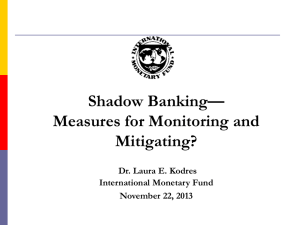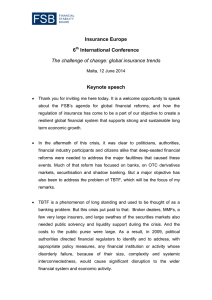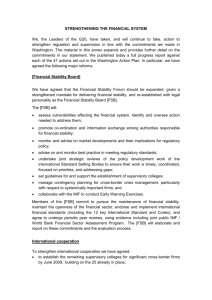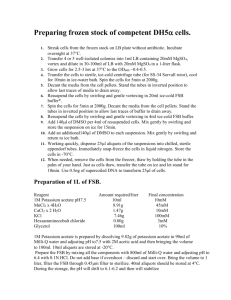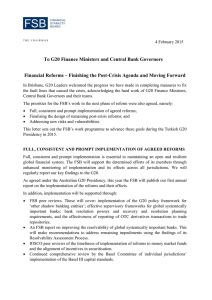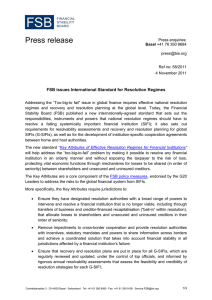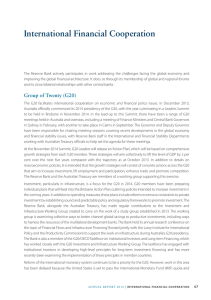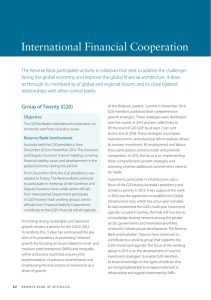Financial reform and regulation: G20
advertisement
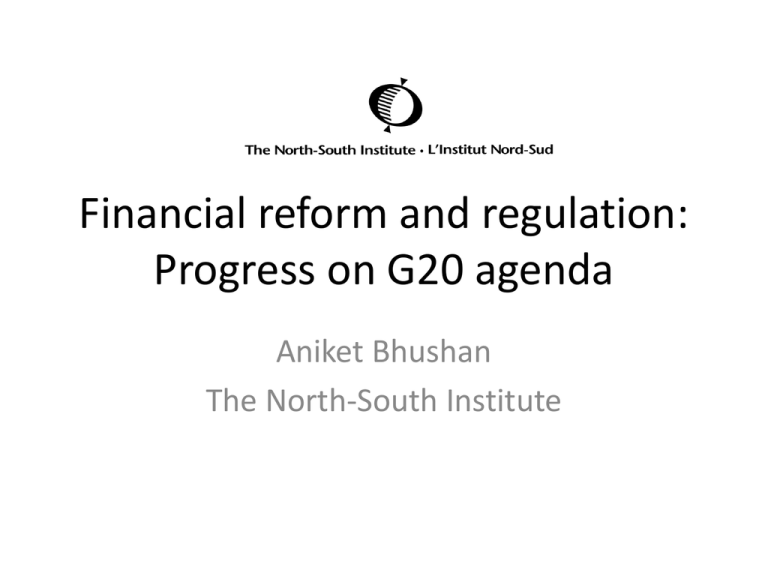
Financial reform and regulation: Progress on G20 agenda Aniket Bhushan The North-South Institute Outline • Understanding financial market failure and crisis • Principles underlying reform & regulatory change • Key reforms, institutions and status • Conclusions • Core: reform areas central to the crisis • Periphery (1): issues related to core crisis • Periphery (2): issues seen as important, but not directly related to crisis (i.e. crisis opportunity to affect wider changes) If we had this would we have avoided the crisis or mitigated impact? Understanding financial failure • Originate-to-distribute model: complex derivatives, but simple maturity mismatches • Leverage and deleveraging cycle (Minsky-moment) • Contagion cycle: financial real political • Contagion: liquidity solvency Amplifiers • Endogenous risk (behavioural) • Counterparty risks • Off-balance sheet, contingent lines - paradox of trust • Excess reliance on ‘wholesale’ finance Broad principles underlying reform and regulatory change Core (well-accepted) • Undercapitalized financial system • Limits of micro-prudential (individual) rationality in regulation, supervision • Limit size, complexity, in some cases interconnectivity of financial inst. • Mother-in-law theory of risk allocation • Ex-ante incentives (bail-in) vs. ex-post (bail-out, levy, taxes) • Continuous markets (risk pricing, market clearing, basic transformation functions – ‘market-maker of last resort’) Peripheral (debated, less accepted) • Economics vs. finance paradigm: scarce liquidity vs. price discontinuity • Limits of fundamentalist efficient-markets paradigm (friction, noise, momentum, info asymmetry) • Monetary system (different from financial) broken Principles and outcomes Outcomes: 150+ specific G20 commitments, unprecedented at global level • Financial re-regulation (leverage, capital, new tools) • TBTF measures & limits • State/authorities as risk absorber of last resort (fiscal costs) Ifs and Buts • Immense coordination, practical implementation challenges • No real broad re-think, within finance-centric paradigm, no clear alt/challenge • Superficial allusions – ‘socially optimal/responsible financial system’; finance and econ development, sustainable growth; almost no link with poverty reduction Fiscal Cost Where you stand, depends where you sit ($, billions) G20 Advanced Emerging 3530 2400 1220 756 639 90 capital injection 461 38.4 used 18 purchase lending (treasury) 5 used 0 purchase lending (CB) 7 guarantees Reforms, institutions, status: Core Basel III, BCBS, CGFS, CBRG • Capital standards, common definition (Tier 1), higher standards (e.g. TCE). Adequacy ratio: min capital requirements – – – – • • • • • High quality cap (common equity) very low bar (2% of risk-w-a); New LCR (liq. Coverage ratio), NSFR (net stable funding ratio) CE and Retained Earning in Tier 1 will rise Contingent capital New leverage ratio (as backstop) New rules on off-balance exposure (higher RW for securitization) New trading book rules Countercyclical buffers and forward looking provisioning Incentivising centralized counterparties; higher cap req. for intrafinancial sector (Com Payment Systems) • Cross-border bank resolution (CBRG, FSB, IMF-WB) Core issues (cont.) • Progress on new trading book rules (Summer 2009) • Cap standards, adequacy: major consultation paper (Dec, 2009); final by Korea Nov 2010(?); Implementation aimed by 2012; but could 2014-16 • Limited on others (esp. new tools, counter-cyclical buffers) • Banking push back: damaging for recovery (IIF) • Major coordination challenges (BCBS-FSB) Remember: global standards are lowest common, most countries have higher national (Pillars 1, 2 and 3) Banks already raising capital Core issues (cont.) Financial Stability Board (FSB) • Recently expanded (G10 -20); main coordinating body (all major national reg. 24 countries, BIS, ECB, EC, IMF, WB, OECD, Basel committees, IAIS, IASB, IOSCO) • 12 key Standards for Sound Fin Sys (macro transparency, market infra, reg and supervision) Core FSB coordinated (cont.) • Coordination, esp TBTF (capital, leverage, liquidity, firm structure, cross-border resolution, fin infra) • Compensation: consultation published March 2010, major differences, implementation review Q2/2011 – Similar IAIS for insurance; IOSCO for investor risk • SIFI implementation progress (FSB report Apr 2010): interim report June 2010 G20, final recommendations Nov G20 – IMF/FSB/BIS systemic importance paper: Oct 2009, progress report by Jun 2010 – FSB Cross-border resolution WG: Oct 2010; IMF studying legal • OTC derivatives to central counterparty (CCP): CPSS, IOSCO, EC, FSB working group, interim policy paper Oct 2010 and early 2011 Core Accounting Standards • Harmonization of IASB (IFRS) and FASB (US-GAAP) – Derivatives under IFRS (Euro) make balance-sheets much larger than US-GAAP – EU proposed review of mark-t-market; off-balance sheet etc. • Cost and fair value accounting • Target completion June 2011 (likely much delay) • Outstanding: change in composition of IASB, less accounting profession rep Core Macro prudential oversight and systemic risks • Covers much of terrain already discussed • FSB progress report June 2010 • CGFS-FSB key: SIFI, systemic leverage, capital, OTC derivatives • IMF/FSB: early warning exercise • Data gaps report: Nov 2010 • Systemic liquidity risk: BCBS-CGFS (May, 2010) • Systemic risk insurance sector: IAIS (2013) Core Credit Default Swaps (CDS) • Buying insurance on neighbour's house and burning it? • Diff perspective: most liquid instrument ($5560trillion), trading even when everything froze • Not transparent, lot of myths (‘naked shorts’); very small no. market makers –easy pol. target • But authorities willingly allowed this market to grow without oversight: 1tr (2001) -57tr (2008) Core CDS and other OTC derivatives cont. • CCP: more transparency, price, vol, spread disclosures; trading limits • State of play: CCP’s introduced in US and Europe (2009); studies in Canada, China, Japan, Russia, S. Africa (expected 2010) • Reg. arbitrage could emerge as major problem as countries very much doing their own thing (FSB) Core Securitization • More loan-by-loan info on ABS, more assessment time. Principle: increase transparency and retention requirements • Eurosystem collateral framework: 2010-11 • US SEC rule proposed April 2010 • BoE consultation launch March 2010 • Expect fight as pre-existing securitization practices across countries v. diff (e.g. Canada, India) • (Link with cap requirements already described – see Basel-III) Core Rating agencies • US: new SEC rules on national CRAs (Sep 2009); EU legislation entered into force (Dec 2009); Aus took effect (Jan 2010); Korea (2009) • Either studying or draft bill proposed (2010): Canada, Japan, Mexico, S. Africa Summary: status of core issues High conceptual clarity Capital adequacy; capital standards ; trading book High/reasonable prospect (with changes; leverage ratios; liquidity ratios; modifications) countercyclical buffers High level consensus Reasonable conceptual clarity Reasonable prospect (in some jurisdictions more than others) Some consensus Charges on SIFI; other macro-prudential systemic risk measures – FAT, FSC (IMF); Financial Crisis Responsibility (FCR) fee (Obama-TARP levy 0.15% of LFI liabilities); market stabilization fund (Germany, US); bonus/payroll taxes (UK, France) Resolution plans –living wills; Volcker-rule Basic concept, low clarity Uncertain prospects No consensus Cross-border resolution regime- its link with national measures (punitive charges, stability funds); bank-tax/levy; FTT/CTT Key national/regional developments US: July 4 bill, sweeping reforms • New ‘council of regulators’ to monitor systemic risk • TBTF: mid-ground between bankruptcy and bailout (funeral plans – orderly liquidation). Compromise Congress/Senate • Stabilization and resolution fund • Volcker separation of prop trading from guaranteed inst. – Limits on market-share, exposure to hedge funds – Under study (2012); no support Canada, Europe • OTC –CCPs; new securitization disclosure; GAAP harmonization • Consumer protection agency Key national/regional developments UK • FSA closure by 2012 (criticized: too narrow rule-compliance focus at expense of big picture) • New powers for BoE: Financial Pol. Committee; Prudential Reg. Authority; Consumer Protection and Market Conduct Euro-zone (EU) • Most far-reaching reforms -greater centralization • New E. Systemic Risk Board; E. Banking Authority; E. Securities Market Authority; insurance (EIOPA) • Proposed deadline end-2010, stalled, possible 2011 • New capital requirement, derivatives directives -2011 • Corp gov. remuneration consultation Sep 2010 • Greater role for IMF (Financial Soundness Index) EU (passport) vs. UK, US fight over hedge-fund reg Periphery 1: core related Monetary system (link to financial) • Adjustment of macroeconomic imbalances and associated ex-rate adjustment (can G20 deliver what G7 did) –key: whose pace, whose terms • Emerging E: macro stability factors diff: – Containing volatile capital flows and asset bubbles – CB toolkit broader (vindicated); selective discretionary cap controls • Reserve accumulation vindicated – Alternatives: IMF –FCL (Colombia, Mexico, Poland) – CB swaps, regional swaps (C-Mai), repo lines (liq. supports) • Peer review mechanisms –FSAP, new FSI Periphery 2 • Tax havens (OECD-TIEA) • Hedge funds; Dark capital pools, algo trading: taxes on financial transactions curb speculation; CTT – Pervasive debt-financing tax bias • ‘Socially productive’ financial innovation – Mandated business model (Volcker) • • • • Inequality as source of financial instability New kind of (non-national currency) monetary sys Meaningful post-crisis fiscal, monetary coordination Countercyclical anti-shock financing limit DC/LIC contagion • New financing for development, climate, poverty reduction Conclusions (caution) • Perimeter of regulation is political (unison in rescue, fragmentation in reform) • Speed, scale, sweeping nature of reform & pol pressures pose major coordination challenges • Stricter reg. will take effect as most G7 under fiscal tightening pressure (2011-15) • Next crisis will emerge from regulatory chaos (arbitrage, contradictions), overreach, lack of coordination Framing interventions • What does a responsible financial system/sector look like? • If new paradigm, what components? • Rather than dramatizing “Gs” consider all are grappling with common unknown unknows – i.e. intervene constructive, coherent, solutions What we have endorsed • Getting definition of financial efficiency right – From risk-reward to risk-social return • Cross-border regulation weakest link • Fin sys. key player in ‘growth with equity’ • Protection vs. protectionism – Do not underestimate imp of systemic integrity (trust) • Broader view of macro stability • State as risk-absorber of last resort: proactive reg./oversight, weathered better (Canada, Australia, India) • Monetary adjustment mechanism (cost): preservation of purchasing power (capital) vs. labor – Countercyclical financing (global), institutionalizing SDR could be part of this, as could regional/multi-swaps Shameless self-promotion • Widening Global Governance: Building on the G20, Aniket Bhushan & Diana Tussie, Canadian Development Report, 2010 • Policy Responses to Unfettered Finance, NSI, 2009 • Beyond Band-Aid Solutions, NSI, 2009 • Mapping the Market Genome: policy brief, Aniket Bhushan & Richard Bookstaber, 2009 • Lessons from the Economic Crisis, The Mark, Jun 2010 • Undoing the Washington Consensus, The Mark, Jun 2009 • Explaining Canada’s Resilience to the Crisis: Securities and Housing Finance, 2010
